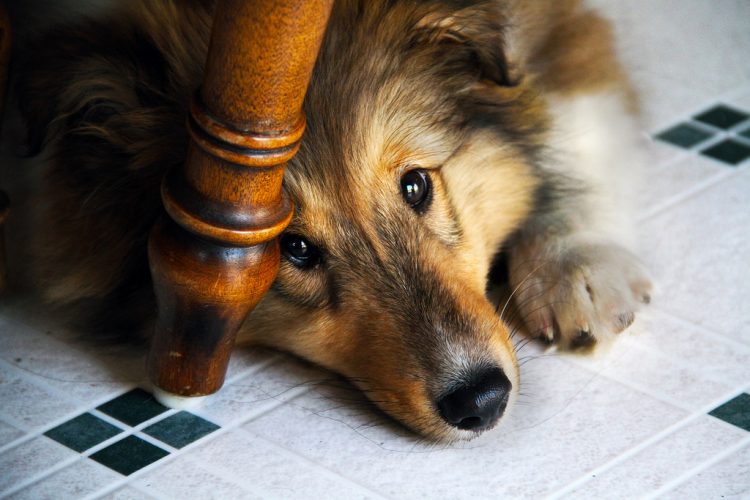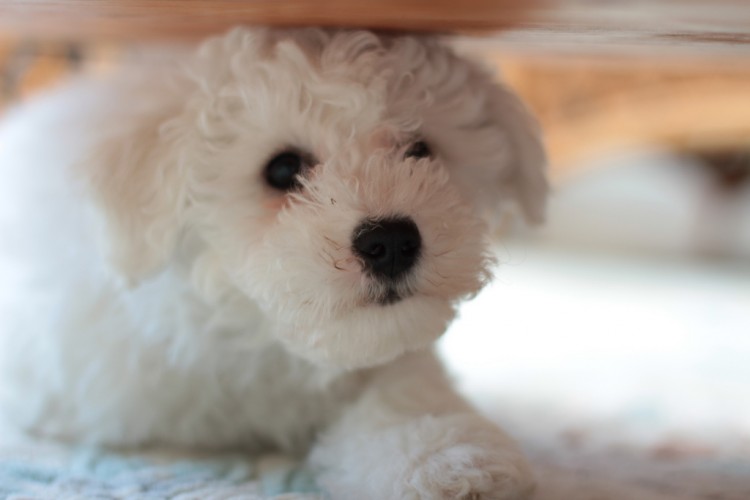
This pet health content was written by veterinarians, Dr. Debora Lichtenberg, VMD, and Dr. Pippa Elliott, BVMS, MRCVS. Petful publisher Dave Baker contributed to this article. It was originally published in 2013 and was last reviewed and updated on June 14, 2024
If you have questions or concerns, call your vet, who is best equipped to ensure the health and well-being of your pet. This article is for informational purposes only and is not a substitute for professional medical advice, diagnosis or treatment. See additional information.

- Effective Tips on How to Calm an Anxious Dog
- Recognizing Physical Signs of Anxiety in Dogs
- Managing Pet Anxiety Over Storms and Loud Noises
- Plan in Advance to Calm an Anxious Dog
- How to Calm an Anxious Dog During Thunderstorms and Other Loud Noises
- Provide a Hiding Place for Your Pet During Thunderstorms or Fireworks
- Medications for Extremely Fearful Dogs
- Pet Anxiety Medications for Storms and Loud Noises
- Facts About Sileo for Dog Anxiety
- Final Thoughts on Medications for Pet Anxiety
- Does the ThunderShirt Work?
- Final Thoughts
- Frequently Asked Questions (FAQ)
Effective Tips on How to Calm an Anxious Dog
Is your dog scared of storms? Cat unsettled by fireworks in the distance?
Your pet is not alone. According to a 2005 survey by the RSPCA, 49% of dogs showed signs of fear around loud noises, with one-third displaying severe reactions such as:
- Extreme restlessness
- Vomiting
- Soiling themselves due to urinary incontinence
Animal shelters often see an increase in strays after thunderstorms because pets run off in fear or are abandoned due to erratic behavior.
Severe reactions to thunderstorms can include:
- Breaking through windows
- Hiding in dangerous places
- Destroying furniture
- Soiling carpets
- Fear of loud noises
In this expert guide on how to calm an anxious dog during thunderstorms and other loud events, we will explore effective methods and natural remedies to help your pet.

Recognizing Physical Signs of Anxiety in Dogs
Some dogs leave you in no doubt of their sound sensitivity. The signs include:
- Pacing and/or whining
- Freezing
- Body posture low to the ground
The stress of noise phobia can affect a dog’s health. Stress hormones decrease the body’s ability to cope and can lead to:
- Recurrent skin infections
- Stomach upsets
- Fear of strangers or strange situations
- Ultimately a shorter life
Managing Pet Anxiety Over Storms and Loud Noises
Veterinarians get a lot of calls about ways to calm an anxious dog during thunderstorms or comforting pets with firework terror or travel anxiety. People often want a “quick fix” for their anxious pets, but a combination of behavior modification and drug therapy takes time and planning.
Plan in Advance to Calm an Anxious Dog
There is no “simple” or “magic” pill to fix complex pet anxieties. Anxiolytic drugs work best as part of a solid behavior modification program. Different drugs or combinations are used depending on the severity of anxiety, duration of therapy, and the health status of your pet.
Behavior Modification
Working on behavior modification can yield amazing results. For example, dogs and cats not used to car travel can become less anxious with gradual introduction:
- Get the pet used to the travel carrier.
- Place your pet in non-moving vehicles first.
- Begin with very short, safe car trips down the driveway and work up to buzzing around the block.
- Do this repeatedly.
Many people discover their pet can become a seasoned traveler and actually enjoy the ride. This takes time and patience — weeks or even months.

How to Calm an Anxious Dog During Thunderstorms and Other Loud Noises
Never fear — you can help your pet, and here’s how:
Desensitize the Dog to Scary Noises
This isn’t a quick fix, and you need to start a minimum of 8 weeks before the scary events occur.
- Expose the dog to audio of scary sounds with the volume turned low (e.g., thunderstorm sounds).
- Reward for calm behavior in the presence of the feared sound.
- Incrementally turn up the volume, but stay within the dog’s comfort zone.
Over the weeks, you’ll find you can turn the volume higher, and the dog stays calm. This thunderstorm noise-aversion therapy for dogs is hugely successful when done correctly.
Use Pheromones
Fit the dog with an Adaptil collar or use an Adaptil plug-in close to your pet’s favorite hiding place. The pheromones, or chemical messengers, send out reassuring signals that can take the edge off mild anxiety in a dog.
Was YOUR Pet Food Recalled?
Check Now: Blue Buffalo • Science Diet • Purina • Wellness • 4health • Canine Carry Outs • Friskies • Taste of the Wild • See 200+ more brands…

- Start using the product at least 2 weeks ahead of any anticipated traumatic event, such as scheduled fireworks.
Bach’s Rescue Remedy
This liquid “natural stress reliever” is a product many people with pets swear by. At around $15 per bottle, it may be worth a shot. Consult your vet first.

Provide a Hiding Place for Your Pet During Thunderstorms or Fireworks
Don’t force the dog or cat to confront their fears — let them hide away. Find a comfortable place, like a plush dog bed, a rug, a crate, or space under a bed, even in the bathtub. A dark, quiet place works best. Add a blanket and items of clothing that smell of you.
Get your pet used to their hiding spot ahead of time by seeding it with tasty treats and a favorite toy. Ideally, set up the den in advance so your pet automatically knows where to retreat to.
Calming Your Pet During the Storm or Fireworks
- Close all windows and doors: Reduces noise and increases safety.
- Draw the curtains: Helps dull the noise.
- Turn off the TV: Avoid adding to the noise.
- Play gentle music: Soft classical music can soothe pets.
- Stay calm: Act like the noise is no big deal. Don’t overly cuddle or appear anxious.
- Avoid verbal cues: Don’t talk to or look directly at your pet during the noise event.
- Stay composed: Don’t punish or yell at your dog for being clingy or obsessive during the storm.
Medications for Extremely Fearful Dogs
In extremely fearful dogs, medication can help in the short term. Drugs from the diazepam family are most effective as they decrease anxiety and have amnesiac properties, which means the dog may forget the trauma of a severe storm or firework display, helping to build confidence in the longer term.

Pet Anxiety Medications for Storms and Loud Noises
Many people believe their pet needs to be tranquilized to handle travel or loud noise, but being immobile doesn’t lessen anxiety. Instead, human anxiolytic and antidepressant medications have revolutionized veterinary medicine. One drug, trazodone, is proving especially useful.
Trazodone
Drugs that help animals with fear and anxiety fall into many classes, including selective serotonin re-uptake inhibitors (SSRIs), benzodiazepines, antihistamines and tricyclic antidepressants.
Trazodone is classified as a SARI (serotonin antagonist and re-uptake inhibitor).
Uses of trazodone:
- Travel anxiety: Anti-anxiety and mild sedative effects.
- Thunderstorm and noise phobias: Useful in acute situations.
- Other anxiety disorders: Helpful for pets needing post-operative or cage rest.
Safety of trazodone:
- Few side effects when used as directed.
- Well-tolerated over a wide dosage range.
- Interactions with other drugs should be monitored.
- Safe for cats but used with caution in patients with severe cardiac, liver, or kidney disease.
Other benefits of trazodone:
- Not expensive.
- Less potential for human abuse.
For more information, see Using Clonidine and Trazodone for Anxiety-Based Behavior Disorders in Dogs.
Sileo — No Longer Recommended
Sileo (dexmedetomidine) was marketed for noise phobias in dogs. However, the FDA issued warnings after reports of overdoses due to faulty oral syringe mechanisms. Despite revised labeling and enhanced training, the risk remains.
Here’s a look at Sileo’s faulty syringe mechanism:
Facts About Sileo for Dog Anxiety
Sileo isn’t new — it’s been around for decades. What’s new is that people now are able to administer it at home to their pets. Sileo, as marketed, is an oral gel to be administered into the dog’s cheek pouch rather than the mouth. You should wear gloves and should not be pregnant, and the drug should be given 30–60 minutes before the fireworks or thunderstorms.
The syringe used to administer the oral gel to canines at home has some reported problems. This is why the FDA is now involved.
What vets are reporting about Sileo:
- Opinions vary widely as to Sileo’s effectiveness for noise phobias.
- Noise phobias are a difficult anxiety to treat.
- The labeling for Sileo claims it does not have to be part of a behavior modification program.
- Vets dispensing Sileo have heard complaints about people not understanding how to use the oral syringe or being worried they gave “the whole syringe.”
For more details, read the FDA’s warning about Sileo here.
Sileo dosing:
- Sileo is supposed to be given in the cheek pouch. If given into the dog’s mouth and down their throat, it is not absorbed well and therefore won’t help relieve the noise phobia.
- You are supposed to wait 2 hours before administering it again — this time, directly into the cheek pouch.
Vets are largely concerned about what happens when someone accidentally overdoses the dog.
- Did the vet fail to instruct the person properly?
- Did the person not watch the Zoetis video, or were they still confused?
- Was Mom, who watched the video, out at the time of the impending thunderstorm and instructed her teenage son at home to put the proper amount of medication into the dog’s cheek pouch?
Until Zoetis fixes the dosing syringe, we advise against Sileo — the pharmaceutical company should fix the problem it created.
Final Thoughts on Medications for Pet Anxiety
As always, please “follow the doctor’s orders” when dosing trazodone or any prescription drug. Don’t increase the drug or use in combination with other drugs without asking your vet first.
Appropriate use of pharmaceuticals may help you and your pets have a calm and relaxing time, even during thunderstorms, fireworks, or travel.
Does the ThunderShirt Work?
The ThunderShirt, a popular vest for pets, applies gentle, constant pressure to help calm pets during stormy weather or fireworks. You can actually use it any time your dog is anxious.
For example, it comes in handy when your pet is:
- Very excitable with strangers
- Pulling on the leash
- Has separation anxiety
- Just generally weirded out in training situations
Does the ThunderShirt work?
Dr. Joe Stratton, DVM, of the Pet Medical Center of Edmond, says he has treated hundreds of dogs with anxiety. He often recommends the ThunderShirt and reports a 50–60% success rate.
A customer shared, “I bought one and it just calms my dog, Sasha, right down. We had a huge thunder and lightning storm at 3 a.m., I found Sasha on the floor in a quivering mass of fear. I put the ThunderShirt on her and she was so much calmer, no shivering, she went back to sleep.”
Note: They make a ThunderShirt for cats, too.

Final Thoughts
No two pets are alike, and not all phobic pets respond to the methods mentioned here. You can’t force your dog or cat to stop being afraid of fireworks, gunshots, thunder, or other loud noises.
So please be responsible, caring, and patient. Work with your pet — and your veterinarian, trainer, or behaviorist if necessary — to find the best way to calm your pet’s noise anxiety.
Frequently Asked Questions (FAQ)
How to calm an anxious dog?
Use a combination of behavior modification, desensitization to triggers, and calming aids like pheromones or anxiety medications.
How to calm an anxious dog at night?
Create a consistent bedtime routine, provide a comfortable sleeping area, and use calming aids such as a ThunderShirt or white noise.
How to calm an anxious dog during a thunderstorm?
Provide a safe hiding place, use desensitization techniques, and consider anxiety medications or calming products like Adaptil.



